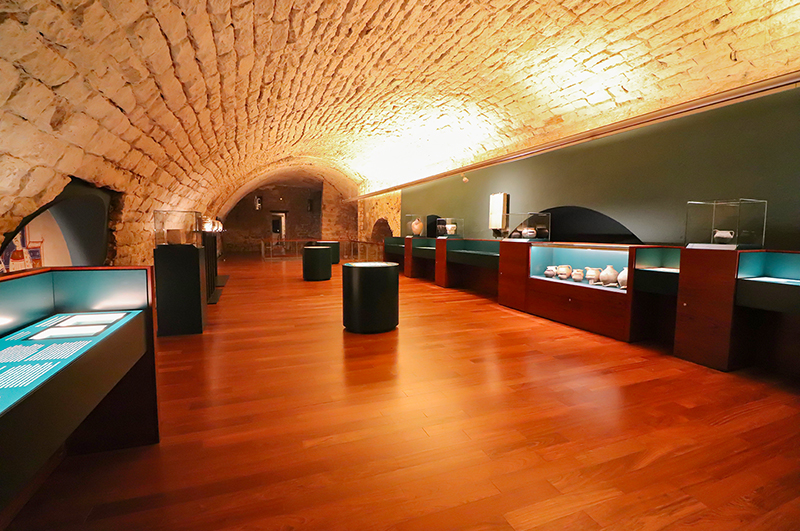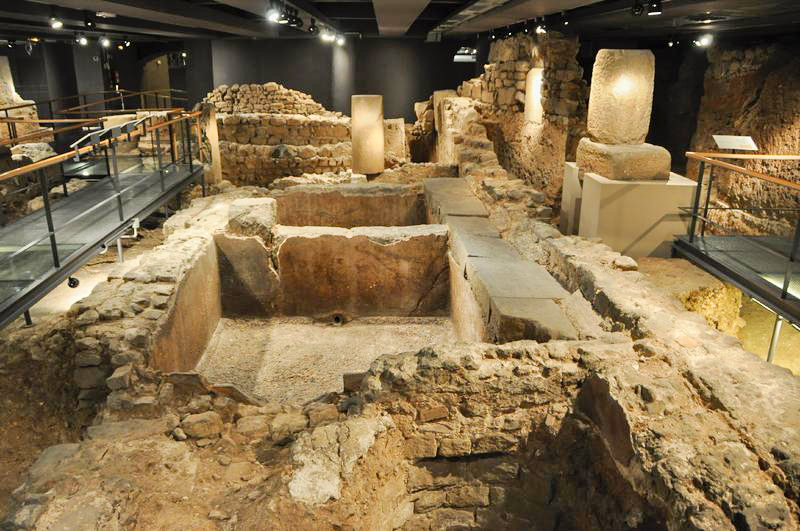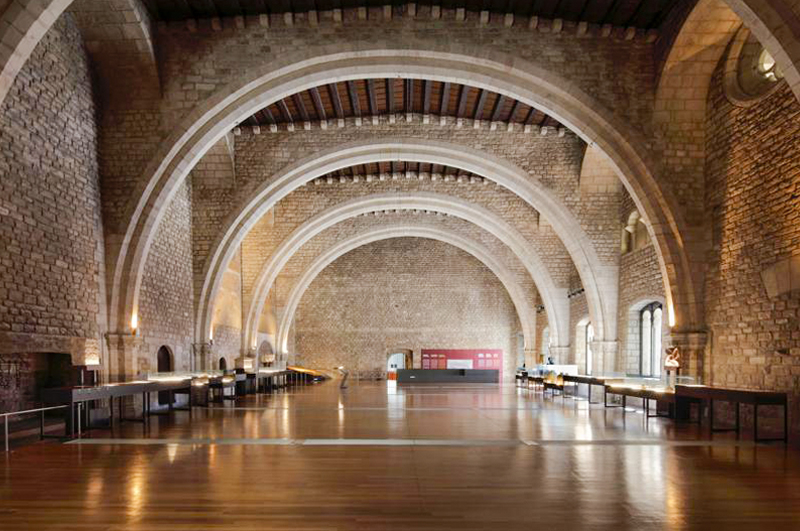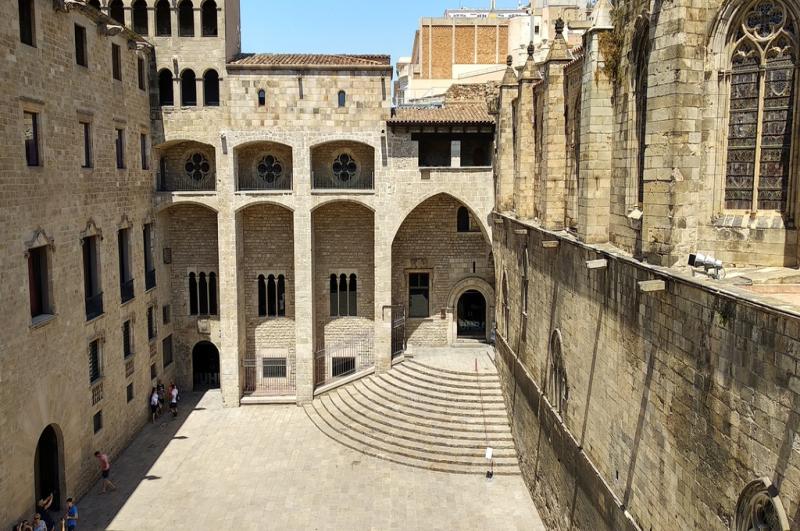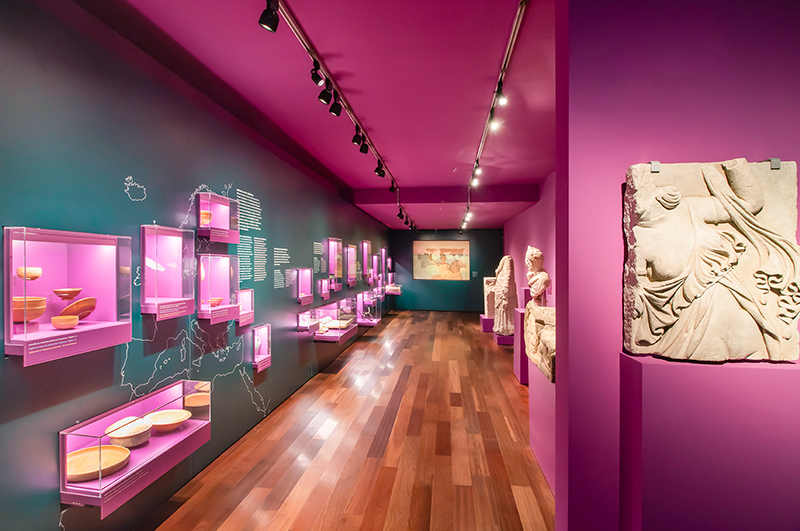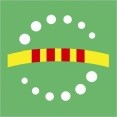Plaça de Rei
The monumental complex of Plaça del Rei has been the founding core of the Barcelona History Museum since its creation in 1943. The remains included in the monumental complex of Plaça del Rei include Roman Barcino from the 1st century BC, Visigothic Barchinona from the 7th century AD and medieval Barcelona from the 13th century. Visitors to this underground area can walk along the streets of Roman Barcelona, past the city wall; they can look around a laundry from the 2nd century A.D. and see the remains of the city's first Christian community, as well as other spaces. This site also features some important medieval buildings, such as Palau Reial, the Chapel of Santa Àgata and Saló del Tinell, in addition to the Gothic palace known as Casa Padellàs.
The site, declared a Site of Cultural Interest, preserves archaeological remains dating from the 1st century BC to the 7th century AD. Vistors will discover a neighbourhood of workshops and processing industries, including a fullonica and a dye house from the 2nd century AD, workshops where clothes were washed and rags or used garments were dyed. They will also visit a cetaria, a factory from the 3rd century AD, dedicated to salting fish and making derived sauces, such as garum. The archaeological tour allows you to enter a winery and see how wine was made during the second half of the 3rd century AD. The episcopal complex of Barcino, consisting of the episcopal hall, the baptistery, the episcopal residence, and a cruciform church, allows us to see the evolution of a part of the city from the 4th to the 8th century.
In the rooms of the main palace, and through the pieces of the collection, the formation of the medieval city and its transformation into the capital of a Mediterranean empire can be seen, as well as its growth and fortification process, leading to the city's government. The role of Barcelona in the context of Catalonia and the Mediterranean, as well as the daily lives of its inhabitants, are also explained.
This complex also includes Casa Padellàs, a former palace from the early 16th century that was moved, almost a hundred years ago, from Carrer Mercaders to Plaça del Rei. Converted into the Casa de la Història, it is an experimental museum space, a project with different formats that addresses Barcelona through urban history and heritage in an environment of research and participatory activities. On the first and second floors, Barcelona Flashback. Historical Synthesis is a general synthesis exhibition that invites us to read the human and urban landscapes of diverse neighbourhoods and then goes on to examine Barcelona and its choices throughout the centuries. The first floor also contains a flexible space for temporary exhibitions.
CURRENT EXHIBITIONS
Temporary exhibition 'Barcelona, port mediterrani entre oceans. El testimoni del vaixell Barceloneta I'
Installation, in the antechamber of the Tinell, of the Barceloneta I ship found at the old Rodalies station, restored by the Underwater Archeology Center and the Barcelona History Museum and installed through to the Port of Barcelona, a member institution of the Museum Circle.
Barcelona Flashback. Historical Synthesis is a synthesis exhibition that showcases Barcelona's two-thousand-year history using a method of interrogative historical reading of documents, objects, architecture, and landscapes.
List of points shown on the map
Adreça
Plaça del Rei, s/n (c/ del Veguer)
08002 Barcelona
Tel. 93 256 21 00
museuhistoria@bcn.cat
Horari de visita
Closed Mondays
Tuesday to Saturday open from 10:00 to 19:00
Sunday open from 10:00 to 20:00
Closed: 1 January, 1 May, 24 June and 25 December.
For guided groups (not schools) see prices here
Informació i reserves
Buy your ticket here
Information
informaciomuseuhistoria@bcn.cat or 93 256 21 22 (from Monday to Friday, excluding public holidays) from 09:00 to 15:00
barcelona.cat/museuhistoria
https://www.facebook.com/museuhistoriabarcelona
twitter.com/bcncultura
Preu
Tickets include access to all MUHBA centres
Standard ticket: 7,30 €
Groups of over 10 people: 5,20 €
Concessions: 5,20 € for under 29, over 65, and holders of Barcelona library cards, unemployed persons, targeta rosa reduïda, large family cards, single-parent family cards and Barcelona Bus Turístic.
Entrance without charge: children under 16, holders of targeta rosa gratuïta, Barcelona Card and Barcelona Card Family, members of ICOM and Catalan Museologist Association, tourist guides, accredited journalists, recognized disability accreditation card, assistants for disabled people, secondary school teachers, 'Gaudir +' promotion. Entrance free to all on the first Sunday of the month; all other Sundays free after 15:00.
For guided groups (not schools) see prices here
Bo Cultural Jove
The MUHBA is a member of the Bo Cultural Jove programme run by the Ministry of Culture and Sports. When you buy your tickets, you can use your physical or virtual Bo Cultural Jove pre-payment card when paying.
If you turn 18 years old next year, you are entitled to benefit from this programme. It is a €400 direct grant to anyone who is 18 years old to purchase and enjoy cultural products and activities. Find out how to make the most out of it and all the details here.
Accessos
Metro: Jaume I (L4)
Bus: 120, V17 and 45
Barcelona Tourist Bus: south route (red)
Recommendations
- We will leave umbrellas or sharp objects at the entrance.
- Photographs can be taken, without flash or tripod, inside the exhibition halls.
- Food and drinks in the reserved space.
- Leave animals outside, unless they are feral dogs.
- It is recommended to silence the mobile phone and not to use it in the exhibition halls.
In this museum we work for sustainability, thank you for your collaboration.



